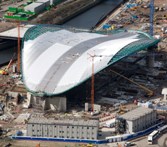
London Looks Ahead
With construction of venues for the 2012 Olympic and Paralympic games well under way, a study commissioned by HSE analyzed the risks and hazards at major sports events around the world. The 2010 FIFA World Cup was insured for a total of about $9.4 billion, according to Lloyd's.
- By Jerry Laws
- Aug 01, 2010
Some 750 days before the opening ceremony for London's 2012 games, workers building the Olympic Park and a carpenter on the project, Alan O'Hagan, received Olympic Delivery Authority Health, Safety and Environmental awards in early July for making the job site both safe and green. At the same time, Britain's Health and Safety Executive published a study it had commissioned to analyze the risks and hazards present during previous Olympics and major sports events and created a website dedicated to safety and health of the 2012 games.
Poor walkways and lack of warning signs during construction work, legionella, falls, small fires, strained public health resources, and violence directed at event staffs were the among the identified concerns.
 The literature search by the Health and Safety Laboratory produced 384 papers, of which 80 met the inclusion criteria. These papers were then reviewed by the research team and summarized by topics that included construction, public health and safety risks, road accidents, injuries, musculoskeletal disorders, crowd safety, emergency planning and response, workplace violence, fire safety, electrical hazards, and carbon monoxide/gas safety.
The literature search by the Health and Safety Laboratory produced 384 papers, of which 80 met the inclusion criteria. These papers were then reviewed by the research team and summarized by topics that included construction, public health and safety risks, road accidents, injuries, musculoskeletal disorders, crowd safety, emergency planning and response, workplace violence, fire safety, electrical hazards, and carbon monoxide/gas safety.
Pipe bombs set off July 27, 1996, in a downtown Atlanta park during the 1996 Olympics and the 1972 Munich attack on the athletes' village by a terrorist group are the best-known terrorism incidents in the long history of the games. This report is focused mainly on more pedestrian hazards, such as the need to train construction workers and to follow Construction Design and Management Regulations (2007) during the building of London-area venues. Waterborne and airborne diseases are a concern identified by the authors, who reported there may be an increased risk of legionella in both sporting venues and seasonal hotels. Staff training in collecting and analyzing medical surveillance data will be important, and a mechanism should be established for immediate reporting of communicable diseases -- including some not prevalent in the United Kingdom, the authors state.
Air monitors have been standard equipment at Olympics games for more than a decade; during the 2008 games in Beijing, that city of 15 million people and the Chinese government went to great lengths to ensure the safety of food, water, air, and facilities while beefing up fire protection and water quality for the region.
Major sports events typically produce an increase in traffic accidents, falls, and traumatic injuries to visitors, the report states. It discusses controls that were applied during past events or were identified as potentially useful.
An event that involves multiple venues, thousands of athletes, and millions of spectators must be insured. Lloyd's estimated the 2010 FIFA World Cup that concluded July 11 in South Africa was insured for a total of about $9.4 billion, with venues insured for about half of that total. The World Cup was expected to draw about 2.75 million spectators.
Already Winning EHS Awards
The Olympic Delivery Authority (ODA) Health, Safety and Environmental awards are in their second year and were judged by an independent panel coordinated by the British Safety Council.
O'Hagan, a carpenter working on a road and bridges at the Olympic Park, won Worker of the Year for his attitude, enthusiasm, and sense of responsibility. Calling himself "absolutely delighted," he thanked his co-workers. "Although this is an individual award, it's been a real team effort, and I'd like to thank all my colleagues who pulled together to make this a safe project."
"Our record on health, safety, and environment is down to the hard work, dedication, and professionalism of the thousands of people who work on the site," said Lawrence Waterman, leader of health and safety for ODA. "As we enter our busiest year on site, we are not complacent. We will continue to work with our contractors, subcontractors, and workforce to make sure the Olympic Park remains the healthiest, safest, and greenest construction site in the country."